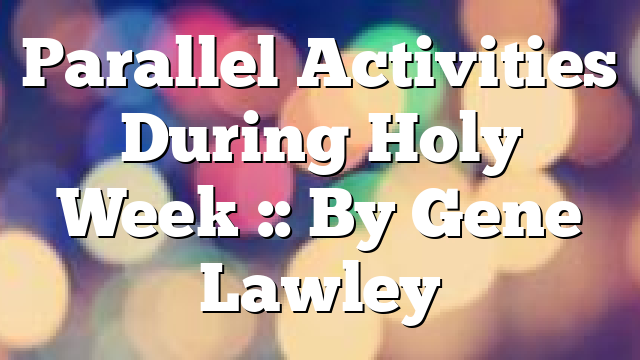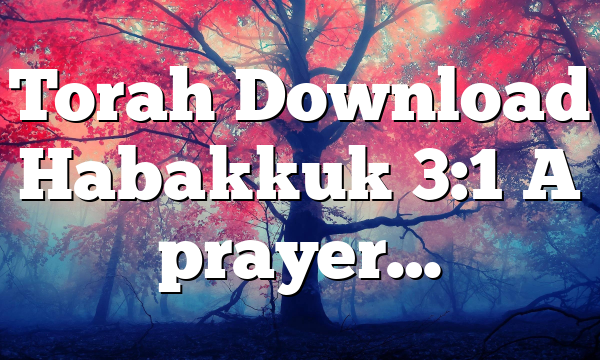Click to join the conversation with over 500,000 Pentecostal believers and scholars
Click to get our FREE MOBILE APP and stay connected
| PentecostalTheology.com



That first Holy Week, when Jesus was on trial and was illegally subjected to death on the cross, has remarkable parallels in traditional Jewish Day of Preparation activities and the activities of Jesus at the same time. What makes it remarkable is John the Baptist’s remark noted earlier, “Behold, the Lamb of God who takes away the sin of the world!” (John 1:29).
The first Passover, when Moses led the children of Israel out of Egypt, had detailed instructions from God. He laid it out in Exodus 12:
- On the tenth day of the first month,
- Each household, with neighbors, if too small in number, so that each person would have their need fully met, would share a lamb;
- The lamb must be without blemish, a male of the first year;
- It may be taken from the sheep or the goats;
- It shall be kept until the fourteenth day of the month, thus, four days.
- The whole assembly shall kill their lambs at twilight;
- It is to be roasted, then eaten, and if any is left over till morning, it must be burned in fire.
Other instructions are given in Exodus 12, but the key parallels to events in the Holy Week are the quality of the lamb and the four days when the lamb is kept with the household. That time may have been to carefully see that the lamb had no blemishes or faults. Or, as a point of reflection on what was to come for the lamb?
That Holy Week began on Saturday evening at sundown and the following day, Sunday, the first day of the selection of the lambs, and the four days ran through Wednesday, the Day of Preparation. (Matthew 27:62-63 tells us of the timing of events then: “On the next day, which followed the Day of Preparation, the chief priests and Pharisees gathered together to Pilate, saying, ‘Sir, we remember, while He was still alive, how that deceiver said, “After three days I will rise.’” (And they ask for guards at the tomb.)
How does that first Holy Week begin for “the Lamb of God who takes away the sin of the world?” (John 1:29 and 1 John 2:2)
On Palm Sunday, He was chosen by the people at His triumphant entry with great acclaim and authority of His overwhelming Person. (The opposing religious leaders asked His disciples to have Him quieten the crowd, and He said, “If they are silenced, the rocks will cry out!”)
On the next day, Monday, He cleansed the Temple of the marketers and moneychangers. On Tuesday, He was in the temple area teaching and making Himself known as the Lamb of God.
During the day of Wednesday, He was with His disciples into the evening time and the Last Supper. Then they went over to the Garden of Gethsemane, where He struggled in prayer regarding His coming ordeal and crucifixion. The disciples, now just eleven of them, were totally unaware of what was going on and that the agony of His suffering was about to be poured out.
The Jewish day began at twilight on Tuesday, running through to twilight on Wednesday. Then began the Day of Preparation at twilight on Wednesday. That Thursday began at twilight on Wednesday and continued until twilight on Thursday, as the Jewish days were counted. It was the end of the fourth day, and roasting the Passover lamb was next by putting it to death and applying its blood as directed by God to Moses.
(These details are confusing, but getting them fixed in our minds is important for understanding how and when the parallel events fell into place.)
Preparation Day for the Lamb of God began with His agony in prayer in the Garden of Gethsemane, followed by being arrested there. It continued with all of the abuses of the questioning in attempts to find a reason for His conviction and “trial” that lasted all night and into the next day, Thursday. Read Isaiah 53 for a detailed picture of His suffering and abuse before, during, and after the trial.
Scourging, whipping, beating, abusive and blasphemous accusations—these are told in the gospel accounts of His treatment. The parallel is like this: While the religious leaders were skinning and preparing their lambs for roasting, the Lamb of God was being effectively “skinned” and made ready to be displayed as sinful as ordinary criminals were.
It is astounding how openly evil man can be in his rejection of truth. The injustice is overwhelming as we unwind the intimate details of His illegal trial. Repeats in like-kind can be seen today as well, showing that mankind is not becoming better and better in moral integrity.
As the parallel continued in the Temple at twilight, the Passover lamb was killed at twilight as the day of Wednesday ended. While that was happening, Roman soldiers were nailing Jesus to the cross on the hill of Golgotha, then lifting Him upright to hang there until death came. He had said prophetically, “And as Moses lifted up the serpent in the wilderness, even so must the Son of Man be lifted up” (John 3:14), then “if I am lifted up from the earth, I will draw all peoples to Myself” (John 12:32).
There were seven statements from Jesus from the cross, not all reported in each of the four gospels. His final four were perhaps in this order:
“Father, forgive them, for they do not know what they do” (Luke 23:34).
“My God, My God, why have You forsaken Me?” (Matthew 27:46).
“It is finished” (John 19:30).
And this one as His ordeal ended with Luke’s account of those three hours of agony hanging there: “Now it was about the sixth hour [3:00 pm], and there was darkness over all the earth until the ninth hour [9:00 pm]. Then the sun was darkened, and the veil of the temple was torn in two. And when Jesus had cried out with a loud voice, He said, ‘Father, into Your hands I commit My spirit.’ Having said this, He breathed His last” (Luke 23:44-46).
Some reminders of the foundation of God’s plan of salvation, not that of man, as the flow of Scripture brings together the parallels to One final conclusion:
Leviticus 17:11 – “For the life of the flesh is in the blood, and I have given it to you upon the altar to make atonement for your souls; for it is the blood that makes atonement for the soul.”
Hebrews 10:1-3 – For the law, having a shadow of the good things to come, and not the very image of the things, can never with these same sacrifices, which they offer continually year by year, make those who approach perfect. For then would they not have ceased to be offered? For the worshipers, once purified, would have had no more consciousness of sins. But in those sacrifices there is a reminder of sins every year.”
2 Corinthians 5:21 – “For He made Him who knew no sin to be sin for us, that we might become the righteousness of God in Him.”
Hebrews 7:25 – “Therefore He is also able to save to the uttermost those who come to God through Him, since He always lives to make intercession for them.”
Psalm 103:12 – “As far as the east is from the west, so far has He removed our transgressions from us.”
The Apostle Paul briefly sums it up in 1 Corinthians 5:7: “Therefore purge out the old leaven, that you may be a new lump, since you truly are unleavened. For indeed Christ, our Passover, was sacrificed for us.”
Jesus died once for all, thus providing the gift of salvation available for all who will accept the gift. The gift is Him, Christ, actually, and “to as many as receive Him, to them is given the authority to be called the sons of God” (John 1:12).
Contact email: andwegetmercy@gmail.com
The post Parallel Activities During Holy Week :: By Gene Lawley appeared first on Rapture Ready.




Most Talked About Today